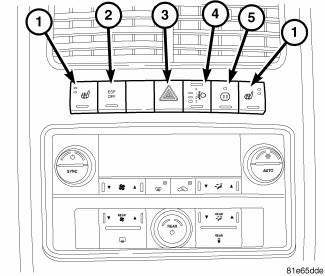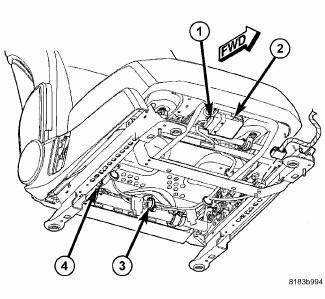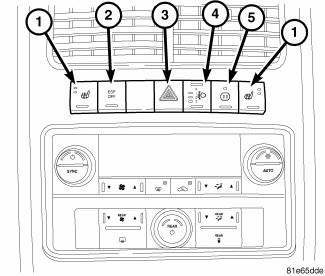Dodge Journey: Description, Operation, Diagnosis and Testing
DESCRIPTION

Fig. 1: Accessory Switch Bank Module
Vehicles with the heated seat option can be visually identified by the two heated seat switches (1) located in the center stack of the instrument panel. The switches are located on the outer edges of the Accessory Switch Bank Module (ASBM). The ASBM is located just below the vents and just above the heater and air conditioner controls in the center stack area of the instrument panel.
The heated seat system allows the driver and front seat passenger to select from two different levels of electrical seat heating (HI/LO). The heated seat system includes the following major components:
- Heated Seat Elements - Four heated seat elements are used per vehicle. Two heated seat elements are integral to each seat, one in the seat back and the other in the seat cushion.
- Heated Seat Module - One heated seat module is used per vehicle. The Heated Seat Module is mounted under the Driver front seat. This module contains the control logic and software for the front heated seat system. The module communicates on the Local Interface Network (LIN) data bus.
- Heated Seat Switches - Two heated seat switches are used per vehicle, one for each heated seat. Both switches are integral to the ASBM mounted in the instrument panel center stack.
- Instrument Cluster (CCN) - The instrument cluster, sometimes referred to as the Cab Compartment Node (CCN) utilizes integrated software and information carried on the LIN data bus. The CCN serves as the link between the heated seat switches and the heated seat module.
OPERATION

Fig. 2: Locating Heated Seat Module
The heated seat system operates on battery current received through a fuse in the Totally Integrated Power Module (TIPM). Fused ignition switch output (Run) circuits are used, so that the heated seat system will only operate when the ignition switch is in the ON position. The heated seat system will turn Off automatically whenever the ignition switch is turned to any position except ON.
A Heated Seat Module (2) is used to control the heated seat system. The module is located under the driver front seat mounted to the seat pan (4). The heated seat module responds to heated seat switch messages and ignition switch status inputs by controlling the 12v output to the front seat heating elements through integral solid-state relays.

Fig. 3: Accessory Switch Bank Module
When either of the heated seat switches (1) are depressed a switch status message is sent to the instrument cluster, sometimes referred to as the Cab Compartment Node (CCN), via the Local Interface Network (LIN) data bus. The CCN then sends a message via the LIN data bus to the heated seat module, signaling the module to energize the heating element for the selected seat. Amber Light Emitting Diodes (LEDs) in the top portion of each switch indicate the level of heat in use: Two LEDs are illuminated for high, one for low, and none for off.
The heated seat module sends the LED illumination message to the CNN via the LIN data bus. The CNN then sends the LED illumination message to the accessory switch bank so that the appropriate LEDs are illuminated for any given heating level. Pressing the switch once will select high-level heating. Pressing the switch a second time will select low-level heating. Pressing the switch a third time will shut the heating elements off.
The heated seat module energizes an integral solid-state relay, which supplies battery current to the heating elements. When high-temperature heating is selected, the heaters provide a boosted heat level during the first four minutes of operation after heating is activated. The heat output then drops to the normal high-temperature level. If high-level heating is selected, the control system will automatically switch to the low level after 26 minutes of continuous operation. At that time, the number of illuminated LEDs changes from two to one, indicating the change. Operation on the low setting also turns off automatically after 30 minutes.
The module will automatically turn off the heating elements if it detects an OPEN or LOW short in the heating element circuit.
DIAGNOSIS AND TESTING
HEATED SEAT SYSTEM
In order to obtain conclusive testing, the heated seat system and the Local Interface Network (LIN) data bus circuit must be checked. Any diagnosis of the heated seat system should begin with, the use of a scan tool and the appropriate diagnostic service information.
Refer to the appropriate wiring information for complete circuit schematic or connector pin-out information.
NOTE: Vehicles equipped with the heated seat option utilize a low voltage cut-off feature. This feature turns off power to the heated seat system anytime vehicle voltage is below 11.7v or above 15.5v. Be certain to check the vehicle electrical system for proper voltage anytime the power seat system appears inoperative.
Before any testing of the heated seat system is attempted, the battery should be fully-charged.
 Heated Seats
Heated Seats
...
 Module, heated seat
Module, heated seat
DESCRIPTION
Fig. 4: Locating Heated Seat Module
The heated seat module (2) is located under the driver front seat. It has a
single electrical connector (1) and a
push pin style retainer that se ...
See also:
Cover, structural dust
Removal
Fig. 172: Belly Pan
1. Raise and secure the vehicle on a hoist.
2. Remove the belly pan (2), if equipped.
Fig. 173: Front Engine Mount Through Bolt
3. Remove the fore/aft crossmemb ...
Monitor, media system
REMOVAL
Fig. 14: Removing / Installing Mounting Fasteners
1. Disconnect and isolate the battery negative cable.
2. Open the video screen to access the mounting fasteners.
3. Remove the mount ...
ENGINE BREAK-IN RECOMMENDATIONS
A long break-in period is not required for the engine and
drivetrain (transmission and axle) in your vehicle.
Drive moderately during the first 300 mi (500 km). After
the initial 60 mi (100 km), sp ...
